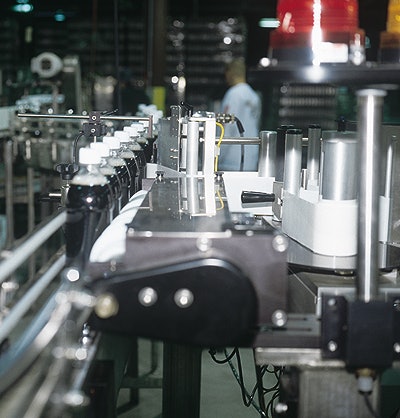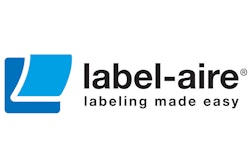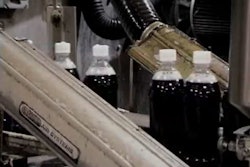Last spring’s addition of a pressure-sensitive labeler is helping regional beverage bottler Black Bear Bottling Group LLC compete with the big boys in its midwestern sales territory.
The Oak Creek, WI-based maker of carbonated soft drinks, water, and lemonade invested in a new Model 3125 labeler from Label-Aire (Fullerton, CA). Before adding the labeler, “we were using a cold-glue applicator that worked with paper labels only,” explains company president Peter J. Caruso. “We still have it [for private-label or co-pack customers who request paper labels], but now with the Label-Aire we use pressure-sensitive labels. That gives us the ability to use more graphics and offer a more professional-looking beverage package.
“Another reason we bought the machine,” Caruso continues, “is that it works much faster. The maximum speed we could achieve with the cold-glue machine was 105 bottles a minute.” That handicapped the line, since the filler could run at 165 bpm. Now the filler can run at that higher speed, says Caruso, “since the Label-Aire can easily do 200 a minute.”
Caruso credits distributor QLC (Hartland, WI) with supplying the labeler. QLC, which specializes in pressure-sensitive labeling equipment, “was instrumental in helping us acquire a labeler that’s provided us with many benefits,” says Caruso.
New plant, too
Caruso explains, “We’re a midwestern bottler at this point, selling within about a 500-mile radius of our plant. About 80 percent of our sales are at retail. Half of that is for our own brands of soft drinks, lemonade, and our Claire Baie bottled water. The other half of retail sales is for brands we co-pack for other companies.” The final 20% of production is either a 5-gal vending tank of ready-to-drink mix sold to churches and festivals, or a bag-in-box configuration of syrup sold to bars and restaurants.
Black Bear operates out of an 80ꯠ-sq’ plant in Oak Creek that houses one bottling line. The firm moved into the facility after outgrowing its 10ꯠ-sq’ home in nearby St. Francis, WI. Oak Creek’s production area is nearly as large as the entire St. Francis plant.
The line at Oak Creek is used primarily for 20-oz PET bottles, though it also runs 12-oz nonreturnable glass bottles and 1-L PET containers. Much of the equipment was used for years at the St. Francis plant. The exceptions are the new labeler, and a used tray former and heat shrink tunnel.
Label advantages
Label graphics usually range from two to four colors. The more colorful labels are used for co-pack customers who request them and for Black Bear’s premium Caruso’s Legacy-branded root beer and cream sodas sold in amber glass bottles. “We developed these beverages about four years ago as a tribute to [my] grandparents, who bought this business in 1961,” he says. “We feel it’s a very rich-looking label, with an image of Grandma and Grandpa on the label.”
A more simple graphics approach is used for Black Bear’s 25 carbonated soft drink varieties. “With this particular package, we try to keep the costs down,” Caruso notes. That helps the company sell the beverages at lower price points, a key competitive tack. The label wraps around half of the bottle, at its waist. That allows consumers to readily see the colorful beverages inside. Labels are color-coordinated to specific beverage varieties.
“We make the highest-quality product at the lowest price point we can,” says Caruso. “And we want consumers to be able to try many flavors and encourage stores to stock our beverages.” Pricing and single-bottle sales of multiple flavors help give Black Bear a competitive edge.
“Most of the major beverage companies tailor sales around 12-packs of cans, eight-packs of 20-ounce bottles, or 2-liter PET bottles,” he explains. “One of the novelties of our product is that we offer a wide variety of flavors that stores can sell by the bottle. That way, a store can offer promotions such as three bottles for 99 cents where a consumer can try three different flavors instead of buying eight bottles of the same flavor.”
The new labels provide another benefit with an outer 1.5-mil layer of polypropylene film that’s adhesive laminated to the printed substrate, which is a 55# semi-gloss paper with permanent adhesive. “The plastic film protects the label so that if a grocery store or a convenience store wants to submerge some of the single bottles in cold water or ice, it won’t damage the label,” says Caruso.
Black Bear acquires labels from distributor Packaging Sales (Menomonee Falls, WI). Packaging Sales sources the labels from different vendors. Black Bear-brand labels are typically printed in two colors; four-color process printing is used for some co-packed products.
The line function
On the day of Packaging World’s visit, Black Bear was packaging cream soda in 20-oz PET bottles supplied by the Watertown, WI, plant of Ball Plastic Container Operations (Broomfield, CO). The 28-mm-finish bottles are shipped in pallet quantities with corrugated slip sheets between layers. Operators place bottles in an unscrambler before they are inverted for rinsing; the bottles are then conveyed right side up to a recently upgraded 40-valve filler. A rebuilt 10-head capper applies a screw-on plastic cap for the bottles. A plastic push-pull sports cap is used for the Claire Baie water.
After capping, bottles are conveyed to a warmer. “In making carbonated beverages, the product has to be around 33 to 35 degrees to gain optimal carbonation,” Caruso explains. “That allows the carbon dioxide to be absorbed into the mixture. When we bottle at that temperature, we need to warm the whole package back up so that the labels will adhere to the bottle.” As bottles are discharged from the warmer, they pass along a conveyor between a set of air knives that blow off the water. The air knives are made by Sonic Air Systems (Fullerton, CA).
Bottles are conveyed single file through an infeed timing screw that spaces them evenly into the Label-Aire labeler. A photoeye senses the incoming bottle, signaling the labeler’s microprocessor to initiate label dispensing. Label rollstock unwinds through a series of dancer rollers that maintain proper tension on the web as it’s fed to the labeling station. The leading label contacts a peel bar that begins to separate the label from its backing web. The edge of the p-s label contacts the bottle, which then begins to spin as a wrap belt wipes the label onto the bottle. The speed of the label applicator and the conveyor are matched to assure proper application.
Downstream of the labeler, bottles are drop packed in a 6x4 configuration into a corrugated tray that’s automatically erected. Trays are then shrink wrapped, with a mechanical pusher moving them through a heat tunnel. Trays are loaded onto pallets and stretch wrapped manually, then shipped by truck either to a distribution center or directly to the store.
Future plans
Black Bear soft drinks in PET have an eight-month shelf life (six months for sugar-free offerings). The line runs about three-and-a-half days a week on one shift during winter; it operates six days a week with an extended shift to meet summer demand.
For the upcoming summer season, Caruso says Black Bear will be able to far surpass its 2002 output of 250ꯠ cases of plastic bottles and 65ꯠ cases of glass bottles. “We’re putting in a second bottling line early [in 2003] next to the current line.”
Caruso explains that the new line “will be used for more of our longer-run, high-speed filling applications, including the 20-ounce bottles. It will also run 1- and 2-liter PET bottles. We’ll use our current line for specialty products and lower-volume beverages.” Equipment will also be added to the current line to automate palletizing and stretch-wrapping functions.
“All the equipment for the second line is already in the plant, and it is either used or remanufactured to save money,” says Caruso. He says the new line will have equipment similar to the current line, but will employ a depalletizer rather than an unscrambler. Also, a 52-valve filler will be added, capable of producing the 20-oz PET bottles at 380 bpm and the 2-L sizes at 180 bpm.
“We’re pleased with our growth,” says Caruso. “And our new labeler is helping us compete with the major brands in our markets.”



























